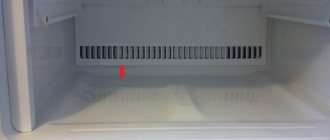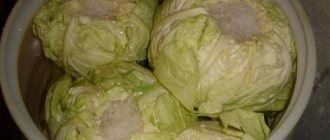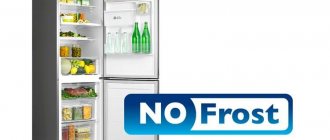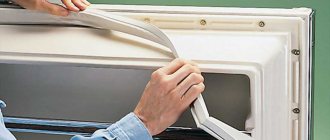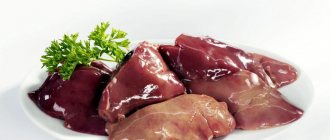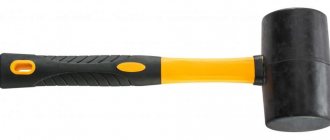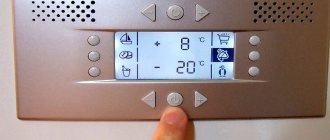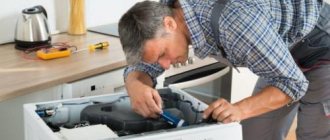- Refrigerator repair
- Note to the hostess
You habitually reached into the refrigerator for groceries, opened the refrigerator door and discovered condensation in the refrigerator. It was formed:
- on the back wall;
- on shelves;
- under the boxes for vegetables and fruits;
- or on products.
The reasons for the formation of condensation are divided into three classes: when this is the norm, when condensation is associated with a violation of the operating rules of the equipment, and when condensation accumulates due to a breakdown. We'll talk about what to do in each of these situations in this article.
When the formation of condensation is normal operation of the refrigerator
In refrigerators with drip defrost of the refrigeration chamber evaporator, condensation on the back wall is not a breakdown, but the operating principle of the equipment provided by the manufacturer. Here's how it works.
There is an evaporator behind the rear wall in the refrigerator compartment. During the chamber cooling cycle, light frost forms on the evaporator and rear wall. As the set temperature in the chamber is reached (from +4°C to +8°C), the cooling is turned off and the temperature of the rear wall rises, tending to the temperature in the chamber. As a result, the resulting frost melts, turns into small droplets of water, flows down the back wall into the drainage hole, and then through the drainage hose into the condensate collection tray on or next to the compressor. During operation, the motor-compressor heats up and evaporates moisture from the bath.
Note! The type of refrigerator with drip defrost in the refrigerator compartment is also called “crying” evaporator refrigerators. Because the droplets of condensation on the back wall are very reminiscent of tears.
What happens if you don't clean the drainage hole in the refrigerator?
If you want to keep the refrigerator in perfect condition, it is recommended to clean the elements of the drainage system, namely rinsing and disinfection, every six months. Because it will not be possible to avoid its contamination even with completely correct placement of products and care.
The elements of the system are constantly in contact with water and bacteria and fungi multiply on their surface. Among them there are many potentially hazardous to health. If the drainage system is in poor condition, the following problems will occur in the refrigerator.
A bad smell appears. At the same time, it cannot be eliminated either by thorough cleaning of the cells, or with flavorings, or with disinfectants.
Products deteriorate, mold and sticky residue appear on them. The safe storage period becomes extremely short.
If the system is clogged, excess water can penetrate through the trim and insulation to the metal parts of the housing. This causes not only their corrosion, but also deformation with a variety of consequences.
When the causes of condensation are violations of operating rules
A refrigerator is a complex piece of equipment, and in order for it to work flawlessly, you must strictly follow the operating rules described in the instructions. Violation of them will result in incorrect operation of the refrigerator and may lead to breakdown. These are the types of violations that cause condensation to form on food, walls and shelves of the refrigerator.
| Signs | What is the reason | How to fix |
| Condensation collects on the walls, shelves, and food in the refrigerator. | Forgot to close the refrigerator door. Most refrigerators beep if the refrigerator door is left open for a long time. But there are models without a sound alarm. In such refrigerators, you only find out that you forgot to close the door the next time you reach into it. Due to the open door, warm air enters the refrigerator compartment and condenses. Moisture collects on cold shelves, walls and even food in the chamber. | You must close the door and never leave it open in the future. |
| Incorrect installation. If the refrigerator is tilted forward, the door of the refrigerator compartment may open slightly on its own (especially if you have not closed it tightly!), and warm air from the room will enter the chamber. The moisture contained in the warm air will be released in the form of condensation on the walls, shelves, dishes, food, and so on inside the refrigerator. | Install the refrigerator level or tilted backwards. To do this, adjust the legs of the refrigerator. | |
| Moisture collects on the walls and shelves of the refrigerator. | Storing liquid foods without a lid. Evaporation from soup, compote and other liquid substances settles in the form of condensation on the walls and shelves in the refrigerator compartment. | Always cover liquid foods with a lid. |
| Condensation forms on the walls, shelves, and food in the refrigerator. | Placing hot foods in the refrigerator. Because of this, the air in the refrigerator compartment heats up and immediately condenses on the cold objects surrounding it. | Allow food to cool to room temperature before putting it in the refrigerator. |
If the operating rules are violated, the formation of condensation inside the refrigerator is temporary. As soon as you start following the rules, the condensation will disappear.
Other ways to clean the drainage hole in the refrigerator
- Using a pump. For purging, use a device used to inflate the wheels of a bicycle or car. It is easier to perform the procedure using a compressor. For preventive purposes, the drainage is cleaned with a pump once a month.
- Soapy solution. 50 g grated laundry soap and 1 tbsp. l. soda is dissolved in 1 liter of water. The liquid is collected into a rubber bulb. The solution is supplied under high pressure. After completing the procedure, the gutter is washed with water.
- Using disinfectant solutions. Some products have an unpleasant odor, but they work well against pathogenic microorganisms. Dezavid is often used to clean refrigerators. It is poured into the hole using a syringe. In this case, you must first close the outlet end of the drainage system. After 5 minutes, the solution is drained and the channel is washed with water.
- Using hydrogen peroxide. An antiseptic is used to treat any surface. A 3% solution is poured into the hole using a syringe or syringe.
- Using the included tube. This is the easiest way to remove the blockage. The device located in the chamber is removed from the mounting socket. Contaminants are pushed towards the tray. After the procedure is completed, the tube is washed and returned to its place.
- Using a sewer cable. The refrigerator is turned with the back wall forward. Carefully remove the protective cover behind which the compressor is located. There is also a container for collecting water. To clean the refrigerator drain, you need to remove the dryer. The bolts securing the container are removed and the tray is removed. The cable is inserted into the drainage channel and pushed upward with forward movements until the end is on the other side. This allows the contaminants in the tube to be removed.
Leak from below
The appearance of drops of moisture on the inside rear wall of the refrigerator is absolutely normal. This is the physical process of condensation of water vapor on a cold surface. However, if there is so much condensate that it flows off in a trickle, this is a signal of improper operation of the device.
The temperature in the room may be very high. This forces the compressor to run for a longer time. The thermostat is set too low.
Loading hot food into the chamber and frequently opening doors also causes increased moisture release.
Some Liebherr models have a BioFresh zone. It is separated by a vertical partition and neither ice nor moisture ever appears in it.
So, if a refrigerator breaks down and water accumulates under it, then you need to go through the entire chain of condensate drainage and evaporation. There's bound to be a problem somewhere. Note that this is an insignificant problem that can be solved independently. In this case, you most often do not need to call a technician, since there is no technical breakdown here.
If you don’t understand why the refrigerator is leaking from below, then let us remind you once again that the drained condensate accumulates on the evaporator - a plastic container that is heated by the compressor. A leak from below indicates that this container is overfilled, broken, or crooked. In this case, water can only flow from below, and the inside of the chambers will be dry.
In order to understand exactly why the refrigerator is leaking from below, you need to unfold it and inspect the compressor. It is usually located at the back of the household appliance and is located at the bottom. An open container can be adjacent to it, installed either on top or end-to-end (it all depends on the model). Many containers (evaporators) are simply glued to the compressor, and when the glue comes off, the evaporators themselves come off, causing water from the drainage hole to simply drip onto the floor. This is where the leak occurs. Also, the evaporator may simply crack, and through the crack water will flow onto the floor.
In some cases, water appears under the refrigerator due to the fact that the condensate flowing into the evaporator simply does not have time to evaporate. This is possible if the refrigerator is forgotten to be closed or opened too often. This leads to a large amount of moisture entering the chamber, which then condenses in large volumes.
In this case, it is enough to simply remove the evaporator (if it is removable) and empty it. If it is tightly glued, you can use a syringe to pump out all the water from it. By the way, an overfilled condensate container may indicate low heating of the compressor. In turn, this indicates a loss of efficiency of its work. However, in this case, you will definitely notice that the device has become weakly cold; the presence of water on the floor will be the last thing that interests you.
In any case, the condensate container (evaporator) is the main reason why water flows from under the refrigerator. There can be no other options. Another thing is when the refrigerator leaks inside.
As you already know, condensation accumulates on the back wall of the chamber and then flows through the drainage hole into the evaporator. This hole may simply become clogged, and then water will not be able to pass through it. Consequently, the container itself for collecting condensate will be empty, and there will simply be nothing to evaporate from there.
We suggest you read: How to remove rust from metal at home?
If this hole becomes clogged (a parsley leaf can get there, for example), then water will flow into the chamber itself. As a result, there will be a puddle at the very bottom of the refrigerator compartment, which over time will become so large that it will simply overflow.
What to do in this case? First of all, you need to find a drainage hole - look for it on the back wall (all food must first be removed). Found it? Look visually to see if anything is preventing the free flow of water to it? If there is any obstacle, it must be removed.
If everything is clean, then there is a possibility of internal blockage. This means that the entire tube must be cleaned. This can be done using water pressure. You can simply pour water from the kettle into it and see if it flows out into the condensate container at the back. Such a flow can move a blockage that the condensate could not move. Still, it flows into the pan in small drops, and not with a powerful pressure.
If you cannot break through the blockage using a stream of water, you can try to remove it using a long wire. Most often this helps solve this problem.
A refrigerator is an essential appliance; replacement or repair cannot wait, and the cost can seriously undermine the family budget. The appearance of water in it is the first sign that something is wrong with the device.
To avoid unplanned expenses, you need to use the device correctly:
- regularly clean the inside of the refrigerator;
- place products at a distance of 2-5 cm from the walls;
- defrost when a fur coat appears; refrigerators with dry freezing are also defrosted at least once a year;
- do not place hot foods inside;
- close the door tightly.
If, nevertheless, the refrigerator begins to leak, you do not need to turn a blind eye to it. Even a minor malfunction, such as a loose door, leads to increased stress on the main parts and accelerates the breakdown of the refrigerator.
A specialist must be called in the following situations:
- leaks in refrigerators with a dry freezing system;
- clogged hole in the freezer;
- breakdown of the thermostat, compressor;
- need to change the pallet.
Water accumulating in or under the refrigerator should not be alarming. In most cases, the problem is solved very simply and is associated with violations of the rules of use. If the device leaks very often, despite regular cleaning, you should definitely contact a specialist.
If, in addition to the water collected outside, drops of water were found on the walls inside, there may be five reasons for the leak:
- The door is constantly not tightly closed or slightly open. When the refrigerator loses cold, it works with increased power, trying to maintain the temperature regime. Water condenses on the walls, forming a crust that can melt and accumulate below, overflowing the drainage. In this case, the door hinges may need to be adjusted. In addition, the door may come off because the refrigerator is not level.
- When the problem is not in the door itself, but the tightness is broken, the seal has become unusable. This part is an elastic band on the door, a kind of layer between it and the body of the refrigerator. If it does not cope with its function, then it is either worn out or deformed due to careless handling. In any case, the seal needs to be replaced. You should contact a specialist to select and install it correctly and firmly. This problem also applies to refrigerators of the “No frost” system.
- When water accumulates under the vegetable drawers, the refrigerator drain hole is most likely clogged. Pieces of food or ice could have gotten in there. The food debris will begin to rot, giving the water a brown color and corresponding odor. To avoid this, it is recommended to periodically wipe the evaporator.
The problem is solved by cleaning the drain. The refrigerator is first turned off and defrosted. You can try to clear the hole by blowing from a straw. Another way is to rinse with warm water (or soda solution) using a syringe with the needle removed or a syringe. In any case, you need to create a fairly strong pressure.
- When the drain drain in the freezer compartment is clogged, water and ice accumulate mainly near the door. To clean it, you need to remove the inner back wall of the refrigerator, since otherwise you won’t be able to get to the hole. It is better not to take risks by following the instructions, but to call a specialist.
- You cannot repair a broken thermostat yourself; it is recommended to contact a specialist. Thermal sensor is a mechanism that regulates temperature and sends signals to the compressor. If the regulation does not work properly, you will need to replace the broken part.
When the liquid is only on the floor, the problem should be looked for in other ways. Experienced craftsmen identify the following reasons why a refrigerator leaks:
- failure of the drainage tube;
- evaporator failure;
- problems with the tank.
This reason is one of the most common causes of refrigerator leaks. Unlike the previously discussed breakdowns, failure of the drainage tube causes only external leakage. Thus, water flows from under the refrigerator, but the chamber itself is dry.
If there is a small leak, but the refrigerator is freezing, this will not affect the food. However, you should not delay troubleshooting and eliminating it. Constant exposure to moisture on the working parts of a household appliance can cause larger breakdowns.
If you are unable to fix the equipment breakdown yourself, the technicians advise you to contact a service center.
In this case, there are several operating rules that will help avoid breakdowns:
- Do not leave the door open. Some people leave the refrigerator open to eliminate the unpleasant odor that appears in the refrigerator compartment. If such an action is performed once, it will not cause much harm to the device. However, frequent ventilation or loose closing of the door causes ice to form on the walls and failure of the main components of the device.
- To prevent clogging of the drain hole located in the refrigerator compartment, you need to be careful when placing food on the shelves. Products should not be placed close to the back wall. Otherwise, pieces of food may get into the drain hole and cause a blockage.
- It is not recommended to place liquids in containers without lids into the chamber. Thus, pots of soup, open bottles of juice or milk contribute to the evaporation of liquid and its settling on the walls of the chamber in the form of frost and ice.
- When defrosting, some try to speed up the process, so they scrape off pieces of ice with a knife or other sharp objects. Doing this is strictly not recommended, because... You can damage the parts of the refrigerator and it will soon leak.
- Dust that accumulates on the back of a household appliance can cause failure of the main parts, so you need to regularly remove dirt.
We suggest you familiarize yourself with Cleaning the washing machine with baking soda and other available products
